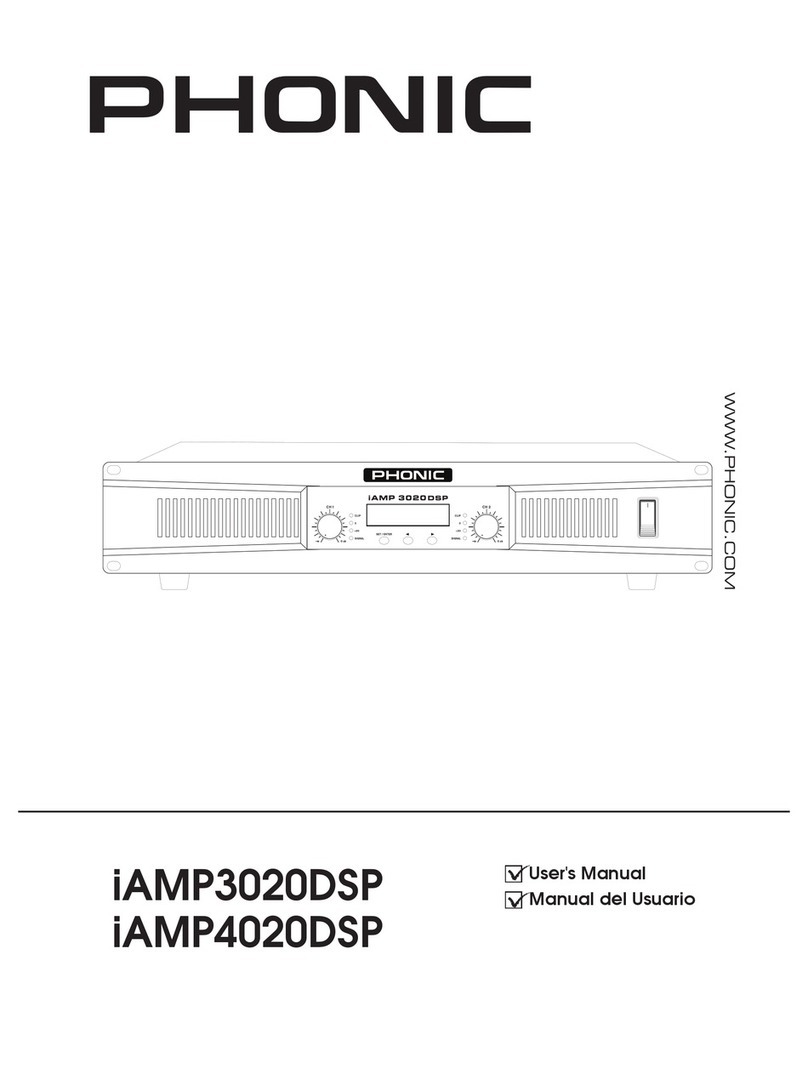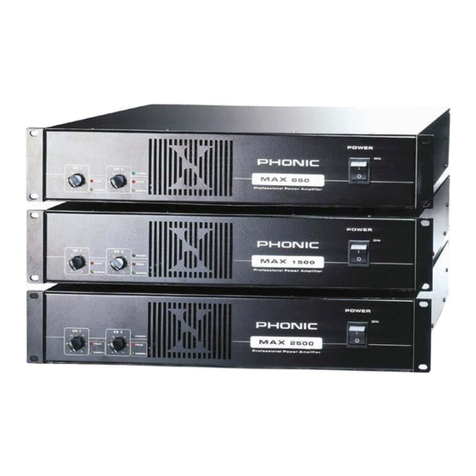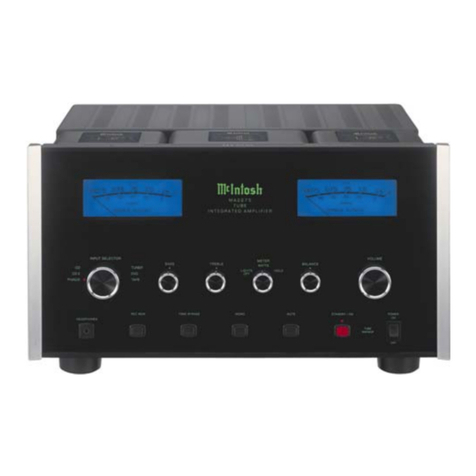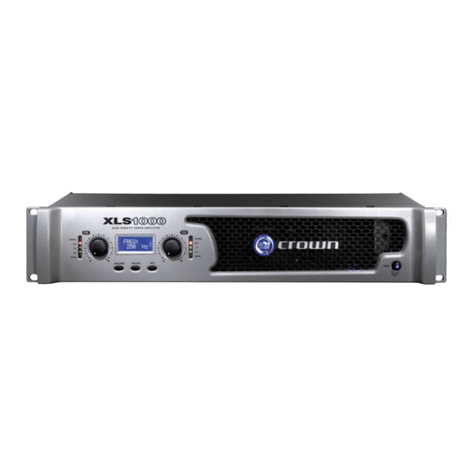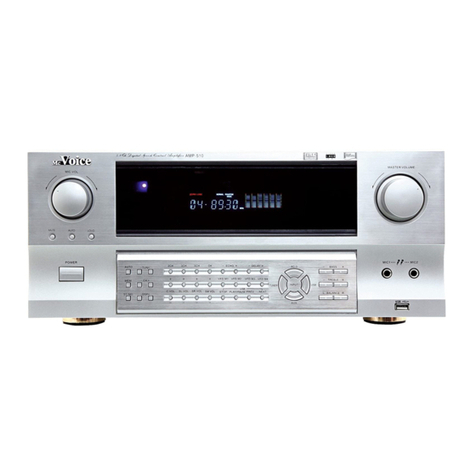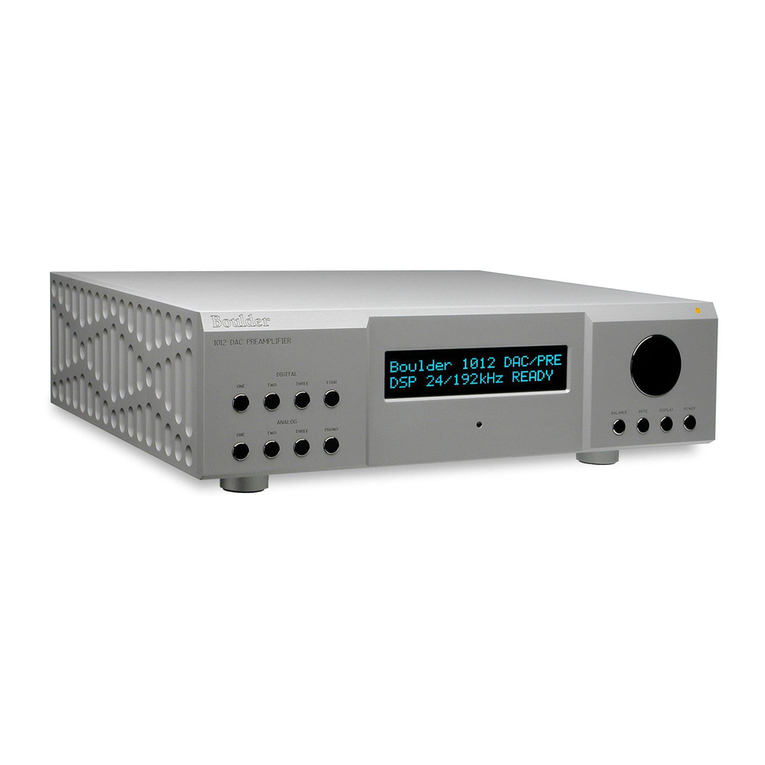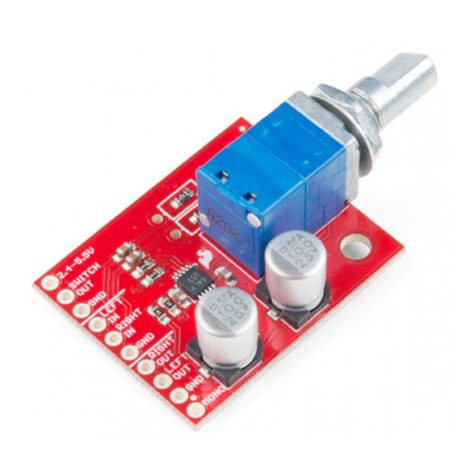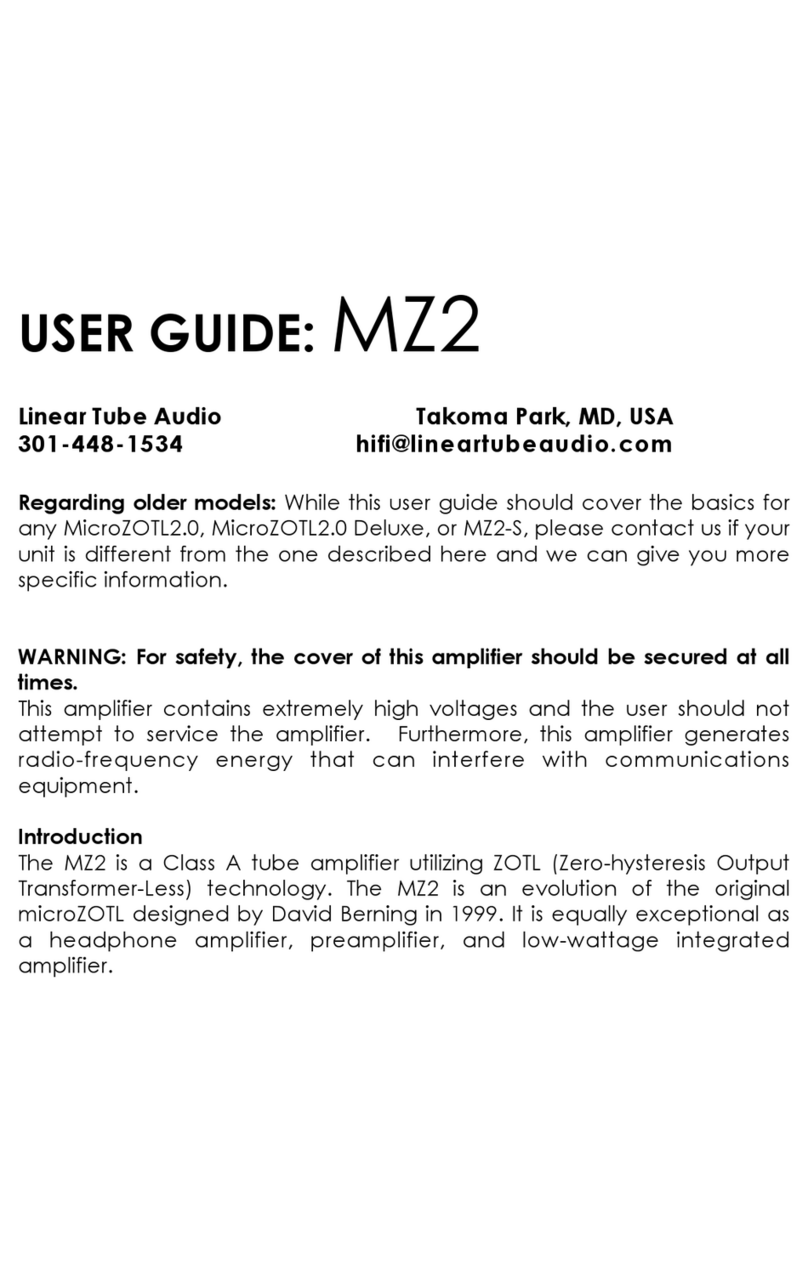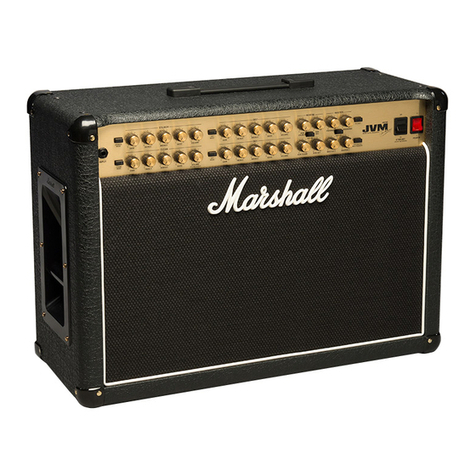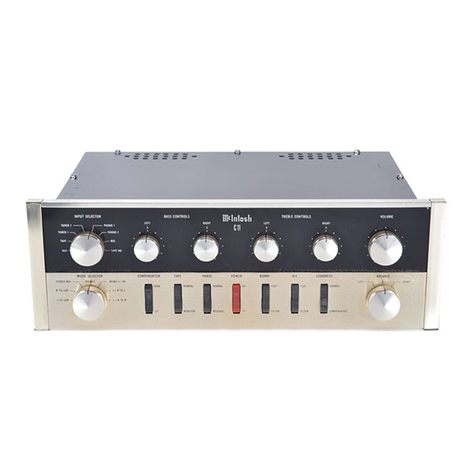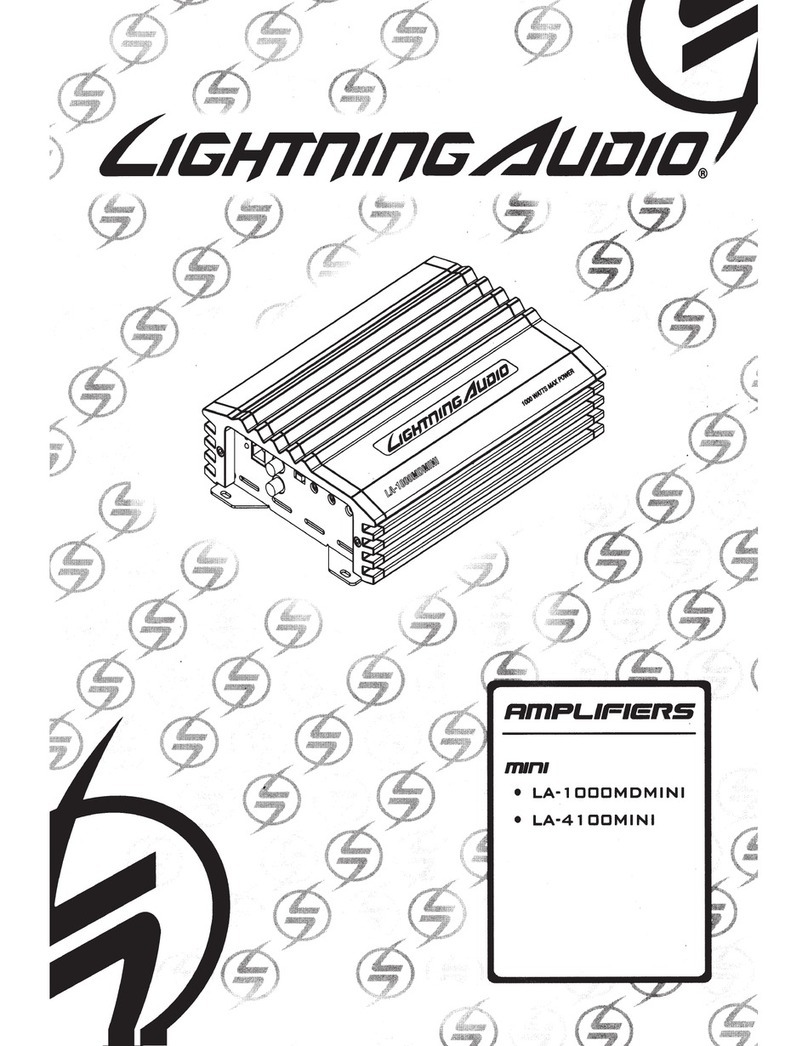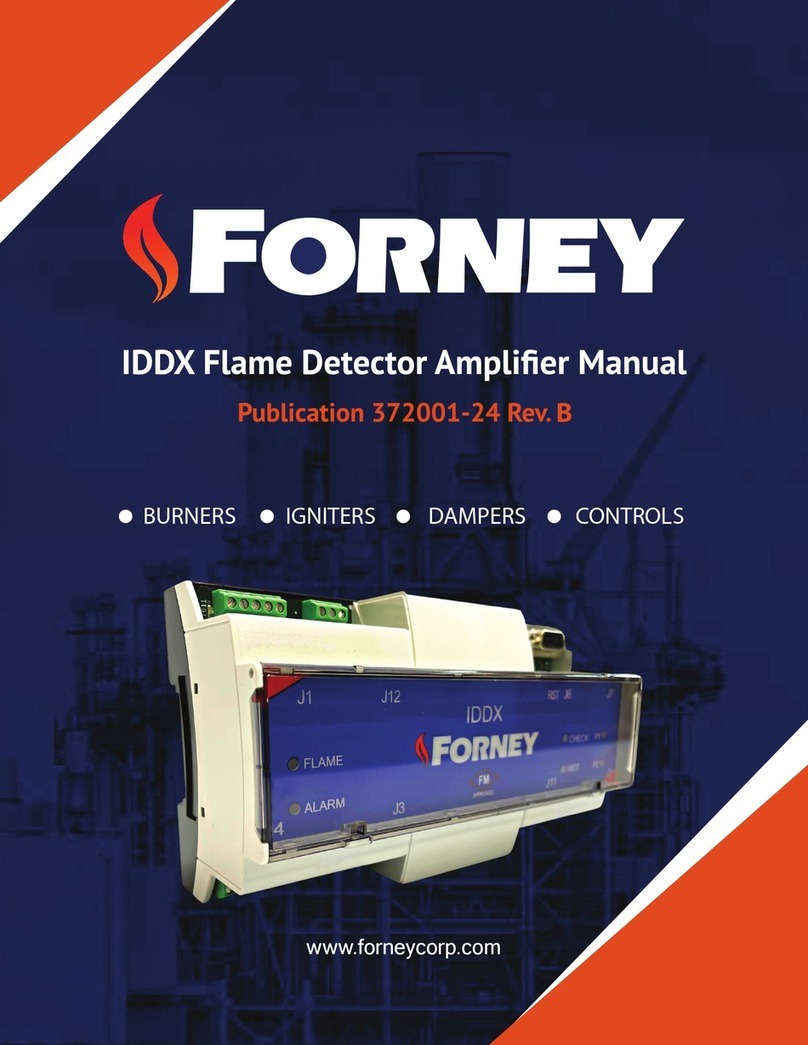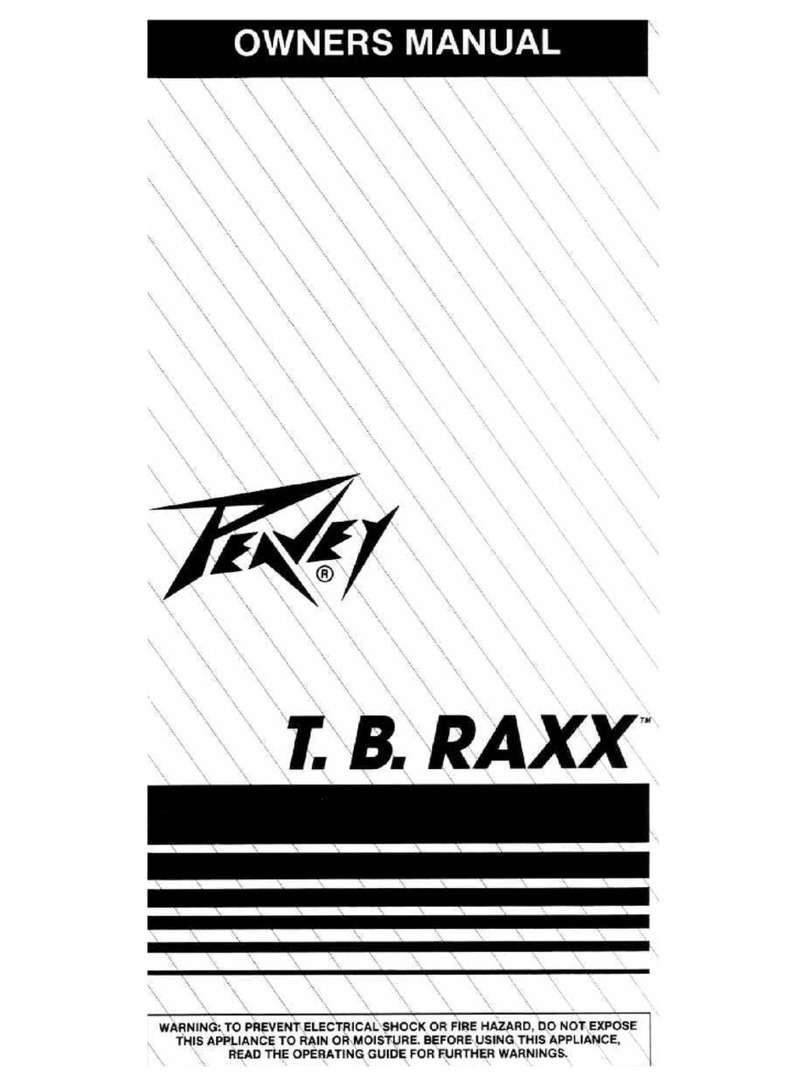Phonic ICON300 User manual

User’s Manual
Manual del Usuario
使用手册
ICON300/ICON700
CONTRACTOR POWER AMPLIFIER
AMPLIFICADOR DE POTENCIA PARA CONTRATISTA
功率放大器
ICON300
ICON700
English / Español / 简体中文

ICON300/ICON700
CONTRACTOR POWER AMPLIFIER
AMPLIFICADOR DE POTENCIA PARA CONTRATISTA
功率放大器
Introduction.................................4
Features......................................4
Precautions.................................4
About This Manual......................4
Front Panel.................................5
Rear Panel.................................5
Balance Barrier Strip Input
Connections......................6
Barrier Strip Output
Connections.......................6
Audio Transformer Outputs.........6
Parallel Mono
Conguration.....................7
Specications..............................8
Block Diagrams.........................21
CONTENTS
Introducción......................................10
Características..................................10
Precauciones....................................10
Acerca de Este Manual..........................10
Panel Frontal.....................................11
Panel Trasero....................................11
Conexiones de Entrada Balanceada de
bornes de Seguridad.............12
Conexiones de Salida de los Bornes
de Seguridad.............................12
Salidas del Transformador de
Audio........................................12
Conguración Mono Paralelo............13
Especicaciones...............................14
Diagrama de Bloque.........................21
CONTENIDO 目录
简介................................16
功能................................16
警示................................16
使用手册........................16
前面板............................17
背板................................17
平衡端子台输入
连接.......................18
端子台输出
连接.......................18
音频变压器输出..............18
并联MONO
设置.......................19
规格................................20
线路图............................21
Phonic preserves the right to improve or alter any information within this document without prior notice
Phonic se reserva el derecho de mejorar o alterar cualquier información provista dentro de este documento sin previo aviso
PHONIC保留不预先通知即可更新本文件的权利
V1.0 11/13/2008

1. Read these instructions before operating this
apparatus.
2. Keep these instructions for future reference.
3. Heed all warnings to ensure safe operation.
4. Follow all instructions provided in this document.
5. Do not use this apparatus near water or in locations
where condensation may occur.
6. Clean only with dry cloth. Do not use aerosol or liquid
cleaners. Unplug this apparatus before cleaning.
7. Do not block any of the ventilation openings. Install
in accordance with the manufacturer
’
s instructions.
8. Do not install near any heat sources such as radiators,
heat registers, stoves, or other apparatus (including
.
9. Do not defeat the safety purpose of the polarized or
grounding-type plug. A polarized plug has two blades
with one wider than the other. A grounding type plug
has two blades and a third grounding prong. The wide
blade or the third prong is provided for your safety. If
the provided plug does not into your outlet, consult
an electrician for replacement of the obsolete outlet.
10. Protect the power cord from being walked on or
pinched particularly at plug, convenience receptacles,
and the point where they exit from the apparatus.
11. Only use attachments/accessories by the
manufacturer.
12. Use only with a cart, stand, tripod, bracket, or
table by the manufacturer, or sold with
the apparatus. When a cart is used, use caution
when moving the cart/apparatus
combination to avoid injury from tip-
over.
13. Unplug this apparatus during lighting
storms or when unused for long
periods of time.
14. Refer all servicing to service personnel.
Servicing is required when the apparatus has been
damaged in any way, such as power-supply cord or
plug is damaged, liquid has been spilled or objects
have fallen into the apparatus, the apparatus has
been exposed to rain or moisture, does not operate
normally, or has been dropped.
IMPORTANT SAFETY INSTRUCTIONS
CAUTION: TO REDUCE THE RISK OF ELECTRIC SHOCK,
DO NOT REMOVE COVER (OR BACK)
NO USER SERVICEABLE PARTS INSIDE
REFER SERVICING TO QUALIFIED PERSONNEL
The lightning flash with arrowhead symbol, within an
equilateral triangle, is intended to alert the user to the
presence of uninsulated
“
dangerous voltage
”
within the
product
’
magnitude to constitute a risk of electric shock to persons.
The exclamation point within an equilateral triangle is in-
tended to alert the user to the presence of important operat-
ing and maintenance (servicing) instructions in the literature
accompanying the appliance.
WARNING: To reduce the risk of or electric shock, do
not expose this apparatus to rain or moisture.
CAUTION: Use of controls or adjustments or performance
of procedures other than those may result in
hazardous radiation exposure.
The apparatus shall not be exposed to dripping or splashing and that no objects with liquids, such as vases,
shall be placed on the apparatus. The MAINS plug is used as the disconnect device, the disconnect device shall
remain readily operable.
Warning: the user shall not place this apparatus in the area during the operation so that the mains switch
can be easily accessible.
CAUTION
RISK OF ELECTRIC SHOCK
DO NOT OPEN

4ICON 300/700
INTRODUCTION
Congratulations on your purchase of the Phonic Icon 300 or 700
power amplier. The Icon Series is a line of professional power
ampliers specically designed for contracting application.
These two models each has independent channels and is
available for driving 200V, 140V, 100V, 70V, 50V or 25V
"constant voltage" lines. Each channel has its own power
transformer (toroidal type) secondary to provide maximum audio
separation (minimum sound leakage) between two channels,
minimizing interaction that can otherwise occur on ampliers
with a common power supply.
FEATURES
● Automatic dual-speed, high efciency fan cooling
● Rear panel detented gain controls for security and
resetability
● Stereo, bridge or parallel operating modes
● XLR and barrier strip inputs
● XLR in and outs for multiple amplier operation & easy
signal pass-through
● Fully short-circuit, temperature and DC offset protection
● Barrier strip connection determines output mode - 25V, 70V,
100V and direct outputs available simultaneously
● Toroidal output transformers provide full electrical isolation
and meet worldwide safety agency approval
● Built-in 45 Hz subsonic lter prevents speaker transformer
saturation with minimal effect on program material
● Power-up muting
PRECAUTIONS
1. When rst powering up the amp, keep the amplier gain
controls all the off, in order to block potentially damaging or
annoying sounds caused by defective cables or hookups.
When turning up the gain, do it gradually, until normal
operation is veried. These precautions are necessary with
all high-power ampliers, since they have enough power to
blow most speakers in abnormal situations.
2. Check the AV Voltage before connecting the AC plug
3. Speaker Output Shock Hazard! The Icon 300 and 700 amps
are capable of producing hazardous output voltages. To
avoid electrical shock, make sure the cover is in place over
the output terminals, and do not touch any exposed speaker
wiring while the amplier is operating.
ABOUT THIS MANUAL
Please be reminded that a power amplier is a high-current,
high-power device and should be treated with respect and care.
Please read this manual before connecting and operating your
unit, and le it in a safe place for future reference.

5ICON 300/700
FRONT PANEL DESCRIPTION
1. Power Switch
The power ON/OFF switch with an LED indicator.
2. Protect LED Indicator
The Icon 300/700 features several types of protection to prevent
damage to the circuitry during turn-on or fault conditions. If the
LEDs light up, this indicates that one of the various protections
is safeguarding the different sections of the amplier and in
these cases, the power output is normally switched off until
normal operating conditions are restored.
Loudspeaker protection: the power-on protection relay
prevents damaging thumps to the speakers as the power
comes on. When the amp is switched on, the protect LED
will light for a few seconds, and then go out, indicating that
the relay has closed.
Thermal protection on the heat sink: If the amp overheats,
thermal shutdown protects the circuitry until the temperature
is reduced to a safe level.
Short circuit protection: The Protect LED Indicator will also
light up if the speaker terminals are short-circuited, or the
impedance of the load is too low. In these circumstances,
the Protect LED will stay on until the fault conditions are
rectied.
Some protection situations require the amplier to be
switched off and then back on for normal operating
conditions to be restored.
3. Clip LED Indicator (Icon 300)
The LEDs light up at clipping status, whenever any conditions
occur that could cause problems for the amp, such as an out-
of-spec load and waveform distortion. Because of the Icon's
ability to enter and exit clipping with as few audible artifacts as
possible, you may not hear any distortion even if the indicator
ashes. In general, a few ashes every now and then will not be
a problem. However, if the LEDs ash often or remain on for any
extended period of time, then turn down the volume controls
to reduce the signal level going to the Icon amp. If this doesn't
solve the problem, check your output cables and speakers.
4.Signal “Status” LED Indicator
Each channel of the Icon 300/700 features a signal LED to show
that there is an audio signal at the input to the channel. The
threshold for the indicator is -26dB, which should be enough to
avoid noise triggering the LED.
5. Limit LED Indicator (Icon 700)
The Icon 700 has a built-in limiter on each channel to prevent
clipping. Should the signal reach a level high enough to cause
clipping (ie. output power is over 400W per channel), the limiter
momentarily reduces the input signal level, just enough to
prevent it. The limit LED lights whenever this occurs.
REAR PANEL DESCRIPTION
6. Gain Controls
These two knobs and the level controls for channels one and
two respectively. Turning clockwise will increase its gain and
counter clockwise will decrease its gain. Please always power-
up with the volume all the way down, and increase the volume
slowly to make sure that no conditions exist which could annoy
your audience or harm your speakers.
7. CH1/CH2 Inputs (XLR Connectors)
These inputs are provided for making balanced connection to
mixers, preamps, etc. The XLR inputs are wired as per the
following convention:
8. Balanced Barrier Strip Inputs
These connection points provide the best option for permanent
or long-term installation. Connections should be screwed down
tight to exclude oxygen, and care should be taken to avoid loose
strands of wire that may cause short circuits.
9. CH1/CH2 Parallel Pass Through XLR Connectors
These XLR output connectors are provided for parallel
connection to another Icon or other amplier.
10. Stereo/Parallel/Bridge Switch
In Stereo operation, two separate signals are treated separately
by channels 1 and 2 of the ampliers.
In Parallel operation, one signal is treated by bother channel
1 and 2 of the amplier. In other words, a signal connected to
Input CH1 (6) or CH2 (7) is sent to both Output CH1 (10) and
CH2 (11).
In Bridge operation, both channels are congured to drive a
single load with a single signal to CH1 (only CH1 is operative,
and CH2 input must be vacant) at twice the power.
This switch should only be used when the Amplier is off;
otherwise the speakers' components could be damaged.
11. Direct Output Connectors, CH1/CH2
These are barrier strips to connect low impedance speakers.
Spade lugs and bare wires should both be screwed down tight
to exclude oxygen, and care should be taken to avoid loose
strands of wire that may cause short circuits.
12. Audio Transformer Outputs, CH1/CH2
These are barrier strips to connect distributed line (25V, 70V,
100V, 140V and 200V). Spade lugs and bare wires should both
be screwed down tight to exclude oxygen, and care should
be taken to avoid loose strands of wire that may cause short
circuits.
+ - 0 70 100

6ICON 300/700
Banlance Barrier Strip Input Con-
nections
Balanced connection - Attach as shown. Connect the (+) wire
and ground wire to terminal pins as marked.
Unbalanced connection - Attach input signal wires as shown.
Use the non-inverting (+) input and the ground terminals of the
header, and also connect a wire jumper between the inverting
(-) input and the ground terminal. The wire jumper will prevent a
reduction in gain caused by a oating unbalanced input.
Input sensitivities -- Audio signals of these levels will produce
full rated output power at 8 ohms.
ICON 300 - 1.02Volts (+2.4dBu)
ICON 700 - 1.02Volts (+2.4dBu)
Barrier Strip Output Connections
Barrier strips located on the rear panel allow speaker cable
connections to the amplier output. See the diagrams for
details on connecting speakers and/or distributed (23-, 70-,
or 100-volt) lines. Insulated connectors of the type shown are
recommended.
Always make sure the amplier is turned off before you
change any output connections.
Loose screw terminals, insert wire connectors under screws.
Tighten screw terminals.
Direct low impedance:
Output connection for Icon 300/700,
bridge mono mode
Output connection for Icon 300/700,
direct low impedance
Bridge Mono Conguration for Direct Outputs
1. Set into bridge mode
2. Connect the signal to channel 1's input only. Do not
connect an input signal to channel 2.
3. Use on channel 1's gain control to set the level. Both
channels' signal and clip indicators should ash identically
when the amplier is operating.
Audio Transformer Outputs
Make sure the sum of the power settings of all the speakers
does not exceed the power rating of the amplier. It is a good
practice to allow a 20% safety margin. For example, if the
amplier has a power rating of 300W, it is always a good idea to
make sure the sum of the loudspeaker loads on the distributed
line is 240W or less.
25 volt line output connection
50 volt line output connection

7ICON 300/700
100 volt line output connection
Bridge Mono Conguration for Audio Transformer Outputs
1. For driving 140V or 200V distributed lines, the amplier must
be set into bridge mono mode.
2. Connect the signal to channel 1's input only. Do not
connect an input signal to channel 2.
3. Use only channel 1's gain control to set the level. Both
channels signal and clip indicators should ash identically
when the amplier is operating.
140 volt line output connection,
bridge mono mode
200 volt line output connection,
bridge mono mode
Parallel Mono Conguration
The "Parallel mode" ties the two channel inputs together so
that both are driven by the same signal, without the need for
external jumpers or wiring. After the inputs, both channels
operate independently. Though they carry the same signal, their
gain controls affect only their respective channels, which must
be used separately. Please refer to the previous Rear Panel
Description. Never parallel the speaker outputs.
Low-Impedance and Distributed Speakers on Icon
Ampliers
If your application calls for connection of an 8 ohm speaker and
a distributed line to the same amplier channel, the Icon 300
and Icon 700 are among the very few ampliers that can do
that. However, since most of the audio power is drawn by the
direct-connected speaker, you must derate the distributed line;
and the distributed line should have a total power load of no
more than one-fourth of the ampliers normal distributed line
power rating.
Computing maximum allowable distributed line load with a
known low-impedance load
MaxTOP = [MaxRatedPL - ((2 x MaxRatedPL)/Impedance)]/2
MaxTOP is the sum of the power taps of the speakers connected
to the Audio Transformer outputs.
MaxRatedPL is the maximum rated power of the amplier into
a two ohm load.
Impedance is the load impedance connected to the direct
outputs.
Example: One channel of an Icon 700 has an 8-ohm load
connected to the Direct (low impedance) output. Then the
maximum power left available to drive a distributed line is:
MaxTOP = [550-((2x550/8)/2)] = 206 Watts

8ICON 300/700
Specications
ICON 300 ICON 700
Direct Power Out
Max.average power at 45Hz-20kHz
With 0.1% THD
8 ohm 120W×2 240W×2
4 ohm 200W×2 400W×2
2 ohm,1kHz,1%THD 300W×2 550W×2
Bridged mono 8 ohm,1kHz,1%THD 420W 850W
Bridged mono 4 ohm,1kHz,1%THD 540W 1100W
Isolated Constant Voltage Out
200V or 140V Bridege 300W 700W
100V or 70V 150W×2 350W×2
25V 120W 280W×2
Frequency Response
Direct Outputs (+0/-2dB) 50Hz-50kHz
Isolated Outputs (+0/-2dB) 50Hz-16kHz
Total Harmonic Distortion <0.05 <0.05
Sensitivity (fro full output) 1.02V 1.02V
Voltage Gain 28dB 32dB
Input Impedance
Balanced/Unbalanced 20k/10k ohm
Damping Factor >200(direct output)
S/N Ratio Less than 100dB below rated output (20Hz-20kHz)
Protection Circuits
Output offset voitage protection
Heat sink overheat protection
Transformer overheat protection
Load shorting protection
Power on/off protection
Controls
Front Panel Power Switch
Rear Panel Ch1 & Ch2 gain controls (41 click); Parallel/Stereo/Bridge switch
Connectors
Input XLR jack ×2,Barrier strip ×1
Output Covered Barrier strip ×2;heavy-duty binding post
Cooling One dual speed fan
Indicators Clip:Red Signal:Green Pro-
tect:Yellow Power:Red
Limit:Red Signal:Green Pro-
tect:Yellow Power:Red
Dimensions(H×W×D) 132×480×428mm 132×480×428mm
Net Weight 24.3KG 24.3KG
Shipping Weight 26.0KG 26.KG


10 ICON 300/700
Introducción
Felicidades por tu compra de los amplicadores de potencia
Icon 300 o 700 de Phonic. La serie Icon es una línea
de amplicadores de potencia profesionales diseñados
especícamente para aplicaciones de contratistas. Estos dos
modelos, cada uno tiene canales independientes y pueden
manejar “líneas constantes” de voltaje de 200V, 140V,
100V,70V, 50V o 25V. Cada canal tiene su propio transformador
de potencia (tipo toroidal) secundario para proveer de máxima
separación de audio (ltrado de audio mínimo) entres los dos
canales, minimizando la interacción que de otra manera pueda
ocurrir en amplicadores con fuentes de voltaje comunes Las
características principales del amplicador incluyen.
Características
• Ventiladores duales de velocidad automática de alta
eciencia
• Controles de ganancia a pasos en el panel trasero para
mayor seguridad y exibilidad de conguración
• Modalidades de operación Estéreo, bridge o paralelo
• Entradas XLR y bornes de seguridad
• Entradas y salidas XLR para operación de múltiples
amplicadores & fácil distribución de señales
• Circuitos de protección total contra corto circuito, temperatura
y offset de salida de DC
• Bornes de seguridad que determinan la modalidad de salida:
- 25V, 70V, 100V y salidas directas simultaneas disponibles
• Transformadores Toroidales de salida que proveen
de aislamiento eléctrico total, y concuerdan con las
especicaciones de seguridad internaciones les
• Filtro subsónico integrado a 45 Hz que previene que los
transformadores de los altavoces se saturen con efectos
menores o con muy poco material de audio
• Protección de encendido (Power-up muting)
Precauciones
1. Cuando enciendas por primera vez al amplicador, mantén
los controles de ganancia completamente hacia abajo, esto
para evitar posibles daños o sonidos molestos causados por
cables defectuosos u otros factores. Cuando incrementes
la ganancia, hazlo gradualmente, hasta que se verique la
operación normal. Estas precauciones son necesarias con
todos los amplicadores de potencia, debido a que tienen el
poder suciente para reventar los altavoces en situaciones
anormales.
2. Revisa el voltaje AV antes de conectar al plug de AC
3. Peligro de Shock Eléctrico a la Salida del Altavoz! Los
amplicadores Icon 300 y 700 son capaces de producen
peligrosos shocks eléctricos a la salida. Para evitar descargas
eléctricas,asegúrate de que la cubierta este encima de las
terminales de salida y, no toques ningún cable de altavoz
que este expuesto mientras el amplicador este operando.
Acerca de Este Manual
Por favor recuerda que el amplicador es un dispositivo de alta
corriente y de alto voltaje, y deberá de ser tratado con respeto y
cuidado. Por favor da lectura a este manual entes de conectar
y operar la unidad, y guárdalo en un lugar seguro para futuras
referencias.

11ICON 300/700
Panel Frontal
1. Interruptor de Encendido
El interruptor de encendido/apagado con un indicador LED.
2. Indicador LED de Protección
Los Icon 300/700 tienen varios tipos de protección para prevenir
daños a los circuitos durante el encendido, o en operaciones no
debidas. Si se ilumina este LED, esto indicara que una de las
muchas protecciones esta cuidando las diferentes secciones del
amplicador, y en estos casos, la salida de potencia se apagara
hasta que las condiciones de operación sean reestablecidas.
• Protección de Altavoz: El relay de protección de encendido
previene de daños por golpes a los altavoces, mientras les
llega el voltaje. Cuando se encienda al amplicador, el LED
de protección se iluminara por unos cuantos segundos, y
luego se apagara, indicando que el relay esta cerrado.
• Protección Termal en el Disipador de Calor: Si se
sobrecaliente al amplicador, la protección termal apagara
al circuito hasta que se reduzca la temperatura a un nivel
seguro.
• Protección de Corto Circuito: El LED indicador de protección
también se iluminara si las terminales de los altavoces están
en corto circuito, o si la impedancia de la carga es muy baja.
Bajo estas circunstancias, el LED de protección seguirá
encendido hasta que se rectique que se tienen condiciones
normales de operación.
Algunas situaciones de protección requieren que el
amplicador será apagado y encendido, y después así
regresara a las condiciones normales de operación
3. Indicador LED de CLIP (Icon 300)
Estos LEDs se iluminaran con el estatus del recorte, en
cualquier momento en que cualquier situación pueda provocar
no linealidades, como una carga fuera de las especicaciones
o distorsiones de forma de onda. Debido a la habilidad de los
Icon para entrar y salir del recorte (Clippoing) con tan pocos
artefactos audibles posibles, podrás no escuchar ninguna
distorsión aun cuando se encienda el indicador. En general,
cuantos parpadeos de estos LEDS por un periodo corto de
tiempo o por cualquier extensión de tiempo, reduce los valores
de los controles de ganancia para reducir el nivel de la señal
que entra al amplicador Icon. Si esto no resuelve el problema,
revisa tus cables de salida y tus altavoces.
4. Indicador LED de Estatus de Señal
Cada canal de los 300/700 tienen un LED de señal para mostrar
si es que se tiene señal de audio a la entrada del canal. El
umbral para este indicador es de -26dB, lo que debe de ser
suciente para evitar que algún ruido dispare a este LED.
5. Indicador LED de Limitación (Icon 700)
El Icon 700 tiene un limitador integrado en cada canal para
prevenir los recortes (clipping). SI la señal alcanza un nivel
elevado para causar el recorte (ejem, la potencia de salida es de
más de 400W por canal), el imitador reducirá momentáneamente
el nivel de la señal de entrada, solo lo suciente para prevenir
esto. El LED de limitación, se encenderá cuando esto ocurra.
Panel Trasero
6. Controles de Ganancia
Estas dos perillas y los controles de nivel para los canales
uno y dos respectivamente. Girar en sentido de las manecillas
del reloj incrementara su ganancia, y en sentido contrario la
reducirá. Por favor siempre enciende el amplicador con
los controles de ganancia completamente hacia abajo, y ve
incrementando el volumen poco a poco para asegurarte de que
no existan condiciones que puedan molestar a tu audiencia o
dañar a tus altavoces.
7. Entradas de los canales CH1/CH2 (Conectores XLR)
Estas entradas están provistas para hacer conexiones
balanceadas a las mixers, preamplicadotes, etc. Estas
entradas XLR están cableadas según la siguiente información:
8. Entradas Balanceadas de Bornes de Seguridad
Estos puntos de conexión provén la mejor opción para
instalaciones permanentes o de largo termino. Las conexiones
deberán ser atornilladas rmemente para no incluir oxigeno, y
se deberá de tener cuidado para evitar perder la rigidez del
cable y que esto provoque cortos circuitos.
9. Paso Paralelo de CH1/CH2 Por Conectores XLR
Estos conectores XLR de salida, están incluidos para
conexiones en paralelo a otros amplicadores ICON o a
cualquier otro amplicador.
10. Selector Estéreo/Paralelo/Bridge
En operación estéreo, dos señales separadas serán transmitidas
por los canales 1 y 2 de los amplicadores.
En operación en Paralelo, una señal es tratada por ambos
canales 1 y 2 del amplicador. En otras palabras una señal
conectada a la entrada CH1 (6) o CH2 (7) es enviada a ambos
canales (10) y CH2 (11).
En operación Bridge, ambos canales están congurados para
conducir una sola carga con un solo canal a CH1 (solo el canal
CH1 esta en funciones, y las entradas del CH2 deberán de
estar vacantes) a dos veces su potencia.
Este selector deberá ser utilizado solamente cuando el
Amplicador este apagado; de otra manera los altavoces y
sus componentes pueden sufrir serios daños.
11. Conectores de Salidas Directas, CH1/CH2
Estos son bornes de seguridad para conectar altavoces de
baja impedancia. Las cuchillas o los cables limpios deberán
atornillados rmemente para que no contengan oxigeno, y se
deberá de tener mucho cuidado para evitar perder la rigidez del
cable o de las terminales de los cables, esto para evitar cortos
circuitos.
12. Salidas del transformador de Audio, CH1/CH2
Estos son bornes de seguridad conectados a las líneas de
distribución (25V, 70V, 100V, 140V y 200V). Las cuchillas o
los cables limpios deberán atornillados rmemente para que
no contengan oxigeno, y se deberá de tener mucho cuidado
para evitar perder la rigidez del cable o de las terminales de los
cables, esto para evitar cortos circuitos.
+ - 0 70 100

12 ICON 300/700
Conexiones de Entrada Balanceada de
Bornes de Seguridad
Conexión balanceada – Como se muestra adjunto. Conecta
el cable (+) y el cable de aterrizaje (ground) a los pines de las
terminales como se esta marcado.
Conexión Desbalanceada - Conecta los cables de señal
de entrada como se muestra. Utiliza la entrada no inversora
(+) y las terminales de aterrizaje (ground) del cabezal, y
también conecta un cable jumper entre la entrada invertida (-
) y la Terminal de aterrizaje. EL cable jumper prevendrá una
reducción de la ganancia causada por una conexión otante
desbalanceada.
Sensibilidades de Entrada – Las señales de audio de estos
tres niveles, producirá una potencia de salida a 8 ohms.
ICON300 - 1.02Volts (+2.4dBu)
ICON700 - 1.02Volts (+2.4dBu)
Conexiones de Salida de los Bornes de
Seguridad
Los Bornes de Seguridad localizados en el panel trasero permiten
hacer conexiones de altavoz a la salida del amplicador. Ve
los diagramas para detalles en las conexiones a altavoz y/o su
distribución (23-, 70-, o 100-volt) de líneas. Conectores aislados
del mismo tipo que se muestra son altamente recomendados.
Siempre asegúrate de que el amplicador este apagado
antes de cambiar cualquier conexión de salida.
Liberal los tornillos de las terminales, inserta las conexiones
de los cables debajo de los tornillos. Aprieta rmemente las
terminales de los tornillos.
Baja impedancia directa:
Conexión de salida para los Icon 300/700,
modalidad bridge mono
Conexión de salida para los Icon 300/700,
baja impedancia directa
Conguración Bridge Mono para Salidas Directas
1. Coloca la modalidad bridge
2. Conecta la señal únicamente a la entrada del canal 1. No
conectes ninguna señal al canal 2
3. Utiliza los controles de ganancia del canal 1 para
congurar el nivel. Ambas señales de canal y sus
indicadores de recorte (clip) deberán estar intermitentes
idénticamente cuando el amplicador este en operación.
Salidas del Transformador de Audio
Asegúrate de que la suma de la conguración de potencia de
todos los altavoces no exceda la capacidad de potencia del
amplicador. Es una buena práctica el dejar un margen de
seguridad del 20%. Por ejemplo, si el amplicador tiene un
calor de potencia de voltaje de 300W, es una muy buena idea
de asegurarse que la suma de las cargas del amplicador en
las líneas de distribución sea de 240W o menos.
25 volt conexión de salida de línea
50 volt conexión de salida de línea

13ICON 300/700
100 volt conexión de salida de línea
Conguración Bridge Mono para Transformadores de
Audio
1. Para manejar líneas de distribución a 140V o 200V, el
amplicador deberá estar en la modalidad mono.
2. Conecta la señal únicamente al canal de entrada 1'. No
conectes una señal de entrada al canal 2.
3. Utiliza únicamente los controles de ganancia del canal 1
para controlar los niveles. Ambos indicadores de señal y
recorte (clip) indicadores deberán parpadear idénticamente
cuando el amplicador este en operación.
140 volt conexión de línea de salida,
modalidad bridge mono mode
200 volt conexión de línea de salida,
modalidad bridge mono.
Conguración Mono Paralelo
La ´´Modalida Paralelo´´, une a dos canales de entrada juntos
de tal manera que ambos llevan la misma señal, sin necesidad
de jumpers externos o cableados. A pesar de la entrada,
ambos canales operar independientemente. Aunque tienen la
misma señal, sus controles de ganancia afectan solamente
a sus canales respectivos, lo que deberá de ser utilizado en
separado. Por favor reérete a la descripción previa del Panel
Trasero. Nunca pongas en paralelo las dos salidas.
Altavoces Distribuidos y de Baja Impedancia en los Ampli-
cadores Icon
SI tus aplicaciones necesitan la conexión de altavoces de 8 ohm
y una línea distribuida al mismo canal del amplicador, los Icon
300 y Icon 700 están de entre los muy pocos amplicadores
que pueden hacer eso. Sin embargo, debido a que mucha
de la potencia del audio es tomada por la conexión directa al
altavoz, deberás de dirigir la línea de distribución; y la línea
de distribución no deberá de tener una carga de potencia total
de no más de un cuarto de las líneas de distribución que los
amplicadores normalmente distribuirán.
• Calculando la máxima carga de disponible de línea de
distribución con una carga propuesta:
MaxTOP = [MaxRatedPL - ((2 x MaxRatedPL)/Impedance)]/2
MaxTOP es la suma de los taps de potencia de los altavoces
conectados a las salidas de los transformadores de Audio.
MaxRatedPL esto es la potencia máxima del amplicador
dentro de una carga de dos ohm.
Impedance es la impedancia de carga conectada a las salidas
directas.
Ejemplo: Un canal de una Icon 700 tiene una carga de 8-ohms
conectada a la salida (de baja impedancia) directa. Entonces,
la potencia máxima disponible para manejar en una línea de
distribución es: MaxTOP = [550-((2x550/8)/2)] = 206 Watts

14 ICON 300/700
Especicaciones
ICON300 ICON700
Salida de Potencia Directa
Potencia Máxima Promedio a 45Hz-20kHz
con 0.1% THD
8 ohms 120Wx2 240Wx2
4 ohms 200Wx2 400Wx2
2 ohms, 1kHz, 1%THD 300Wx2 550Wx2
Mono Bridge 8 ohms, 1kHz, 1%THD 420W 850W
Mono Bridge 4 ohms, 1kHz, 1%THD 540W 1100W
Salida de Voltaje Aislada Constante
200V o 140V Bridge 300W 700W
100V o 70V 150Wx2 350Wx2
25V 120W 280Wx2
Respuesta en Frecuencia
Salidas Directas (+0/-2dB) 50Hz-50kHz
Salidas Aisladas (+0/-2dB) 50Hz-16kHz
Distorsión Armónica Total <0.05 <0.05
Sensibilidad (salida completa) 1.02V 1.02V
Ganancia de Voltaje 28dB 32dB
Impedancia de Entrada
Balanceada/Desbalanceada 20k/10k ohms
Factor Damping >200 (Salida directa)
Relación S/R Menor a 100dB debajo de la salida medida (20Hz-20kHz)
Circuitos de Protección
Protección de offset de voltaje de salida
Protección de disipador de calor de sobrecalentamiento
Protección de sobrecalentamiento de transformador
Protección de corto de carga
Protección de encendido/apagado
Controles
Panel Frontal Botón de encendido
Panel de Dorso Controles de Ganancia Ch1 & Ch2 (41 clicks); selector Paralelo/Estéreo/Bridge
Conectores
Entrada XLR jack x2, Bornes de seguridad x1
Salida Bornes de seguridad x2; binding post resistente
Enfriamiento Un ventilador de velocidad dual
Indicadores
Clip: Rojo; Señal: Verde
Protección: Amarillo
Encendido: Rojo
Limitador: Rojo; Señal: Verde
Protección: Amarillo
Encendido: Rojo
Dimensiones (AlxAnxP) 132x480x428mm 132x480x428mm
Peso Neto 24.3 Kg 24.3 Kg
Peso de Embarque 26.0 Kg 26.0 Kg

CAUTION
RISK OF ELECTRIC SHOCK
DO NOT OPEN
PHONIC CORPORATION

16 ICON 300/700
简介
恭喜您购买Phonic Icon 300/700功率放大器.Icon系列是具有
专业高水平的小型功率放大器.这两款各有独立的声道,可驱
动200v,140v,100v,50v或25v的稳压电平.每声道带有的
电源变压器辅助用作两声道之间的音频隔离,使用同一幻象电
源时,声道之间的影响度能最小化.
功能
自动高转速散热风散
背板测定增益控制,指示正常与重设状态
立体,桥接或并联运行模式
XLR和端子台输入
用于各种讯号快速便捷的XLR输入和输出
完全的高温, 短路和DC偏移保护
端子台连接输出模式:25V,70V,100V和同时直接输出
环形变压器经国际安全标准认证,具有充分的电隔绝作用
内建45Hz超低音滤波器,有效防止变压器饱和时对程序材
料的影响
过载保护
警示
1. 当功率放大器出现过载时,为防止损坏的接线或连接装置对
音质产生影响,增益控制应调至最小.再将增益设置逐渐调
至适于正常效果位置上.该提示对于强大功率的放大器来说
是必不可少的,因为在任何不留意的情况下都可能损坏音
箱.
2. 连接AC插座时请先确保电压是否符合
3. 音箱输出的触电危险.Icon 300/700带有危险输出电压,为
避免电击,请勿打开前后面板,或在放大器运作时触摸外露的
音箱.
使用手册说明
特此向您提醒功率放大器为高电流,强大功率输出的设备,使
用机器前请仔细阅读产口说明书,并妥善保管;操作此机时请
勿必小心谨慎.

17ICON 300/700
前面板
1.电源开关
电源ON/OFF开关带有LED指示灯.
2.保护LED指示灯
Icon300/700为确保电路的安全提供了多种保护途径.如果指示
灯照亮,放大器的不正常运作传达警示讯号,此时用户应立即
切断电源输出,直至安全为止.
扬声器保护:继电器可有效防止电源开启后瞬间内过强电源
的冲击.打开机器后,保护指示灯照亮几秒钟后自动熄灭,
指示续电器已关闭.
过热保护:放大器过热时,此功能会自动保护电路不被损
坏,直至温度降至安全范围内.
短路保护:音箱输出终端出现短路或阻抗过低,此种情况下
保护指示灯持续照亮直至安全为止.
部分放大器的保护功能需关闭开关,再重新开启设定为安全运
作状态.
3.削减指示灯(ICON 300)
消减讯号时即为非线性状态,如空载或波形失真.Icon 300/700
进入或退出削减状态带有可视显示,指示灯闪亮你可能听不到
有任何失真,如果偶尔闪动并无大碍,持续闪动就应适当地削
减讯号电平.如还不能解决问题,请检查输出接线和音箱.
4.讯号状态指示灯
Icon 300/700 的讯号指示灯为每一声道音频讯号的输入提供了准
确的直观显示.指示灯的门阀值为-26 dB,足以消除噪音激活指示
灯.
5.削波指示灯(ICON 700)
Icon 700内建限幅器防止削波.当讯号过大产生削波失真时(每
声道输出功率超过400W)限幅器即刻减小输入电平,此状态下
限幅指示灯照亮.
背板
6.增益控制
这两个旋钮分别控制声道1和2的电平.向右旋转削减增益,功
率过大时音量应打至右端,再逐渐增加音量至理想状态.
7.声道1/声道2输入(XLR连接端子)
此输入接受平衡式讯号,连接至混音器,前置放大器等.XLR输
入按以下图标连接.
8.平衡端子台输入
此连接端子为永久性或长期性安装提供了最佳选择.连接端应
旋紧以避免电线松弛而引起短路.
9.声道1/声道2并联送入XLR连接端口
此XLR输出连接端并联至另一ICON或放大器
10.立体/并联/桥接开关
立体模式时,放大器声道1和声道2的讯号分别处理.
并行模式时,一路讯号可由声道1和声道2共同处理.讯号送
入输入声道1或声道2,再送至输出声道1和输出声道2.
桥接模式,两声道都可发送一路讯号至声道1(声道2必须是空
留),此时驱动两倍功率.
当放大器关闭时,开关为off状态,否则会损坏音箱组件.
11.直接输出连接端口,声道1/声道2
由端子台连接低阻抗音箱.接线片和裸线应牢固旋紧以免电线
松散而发生短路.
12.音频变压器输出,声道1/声道2
经端子台输出不同线性(25V,70V,100V,140V和200V).
芯片和裸线应牢固旋紧以免电线松散而发生短路.
+ - 0 70 100

18 ICON 300/700
平衡端子台输入连接
平衡式连接如下图所示.按标示连接电线正极端和接地线至终
端芯片.
非平衡式连接:按图标连接电线.使用非反向输入连接接地终
端座,同样在反向输入与接地终端连接跳线.跳线可防止由浮
动非平衡式输入引起的增益削减.
输入灵敏度:音频讯号电平产生8ohms的最大输出功率.
ICON300 - 1.02Volts (+2.4dBu)
ICON700 - 1.02Volts (+2.4dBu)
端子台输出连接
位于背板的端子台以连接音箱接线至放大器输出.详细请参看
附表的音箱连接不同线性行为23v,70v,100v)建议您使用绝
缘连接器.如需更换输出连接请勿必关闭放大器.
旋开终端座插入电线连接器,再旋紧终端座.
直流低阻抗
ICON300/700输出连接,
桥接Mono模式
ICON300/700输出连接,
直流低阻抗
直流输出的桥接MONO
1. 设定为桥接单声道模式
2. 仅连接声道1输入讯号.
3. 运用声道1的增益控制设定电平,指示灯同时显示声道讯号
和削减状态.
音频变压器输出
请确保使用的音箱功率总和不超过放大器最大功率值.保留
20%安全余留指数为最佳运行状态.例如,放大器功率为
300W,此时音箱分布线性的功率总和应不多于240W.
25 volt高电平输出连接
50 volt高电平输出连接

19ICON 300/700
100 volt高电平输出连接
音频变压器输出的桥接单声道设置
1. 驱动140或200v线性讯号,放大器应设定为桥接单声道模
式.
2. 仅连接至声道1输入讯号.
3. 使用声道1的增益控制设定电平,指示灯同时显示声道讯号
和削减状态
140 volt高电平输出连接, 桥接单声道模式
200 volt高电平输出连接, 桥接单声道模式
并联mono设置
并联单声道模式就是将一AMP内两声道并联成单声道,无需
外接跳线或接线传输同一讯号.虽然这两声道传输同一讯号,
其增益控制只影响各自声道,可单独设定.切勿并联音箱输出
低阻抗和icon放大器的分布式音箱
如果您需80hms音箱和分布接线连至同一放大器声道,
icon300/700是最适合不过了.多数音频电源都是直接连接音箱
的,因此必须减少分布的接线,通常其总和功率承载不超过放
大器分布接线的1/4.
由已知阻抗计算最大分布线承载量公式
MaxTop=[MaxRatedPL-((2×MaxRatedPL)/Impedance)]/2
MaxTop是连接至变压器输出的音箱分接功率的总和
MaxRatedPL是放大器2ohms时的最在功率
Impedance是连接直接输出(Direct Output)的负载阻抗
例:Icon700的一支声道阻抗为8ohm,连接(低阻抗)直接输出
(Direct Output).计算分布线的最在功率是:
MaxTop=[550-((2×550/8)]/2=206W

20 ICON 300/700
规格
ICON300 ICON700
直接功率输出
最大平均功率
8 ohm 120W×2 240W×2
4 ohm 200W×2 400W×2
2 ohm,1kHz,1%THD 300W×2 550W×2
桥接mono8ohm,1kHZ, 1%THD 420W 850W
桥接mono4ohm,1kHZ, 1%THD 540W 1100W
隔离持续电压输出
200V or 140V桥接 300W 700W
100V or 70V 150W×2 350W×2
25V 120W 280W×2
频率响应 隔离输出
直接输出(+0/-2dB) 50Hz-50kHz
隔离输出 50Hz-16kHz
总谐波失真 <0.05 <0.05
灵敏度 1.02V 1.02V
电压增益 28dB 32dB
输入阻抗
平衡式/非平衡式 20k/10k ohm
阻尼因数 >200(direct output)
信噪比 <=100dB 额定输出 (20Hz-20kHz) 以下
电路保护
输出抵消电压保护
散热片过热保护
变压器过热保护
负载削减保护
控制
前面板后面板 电源开关
后面板 Ch1&Ch2增益控制(41click),并联/立体/电桥开关
连接器
输入 2個XLR插座,1個端子台,
输出 2个COVERED端子台,
接线柱
冷却 一个双速风扇
指示灯
削波:红
信号:绿
保护:黄
电源:红
限幅:红
信号:绿
保护:黃
电源:红
尺寸 132×480×428mm 132×480×428mm
凈重 24.3KG 24.3KG
装船货物重量 26.0KG 26.0KG
This manual suits for next models
1
Table of contents
Languages:
Other Phonic Amplifier manuals

Phonic
Phonic SAFARI 1000 M User manual
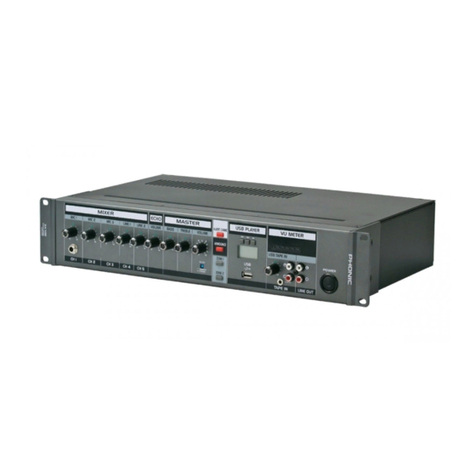
Phonic
Phonic ZA100 User manual
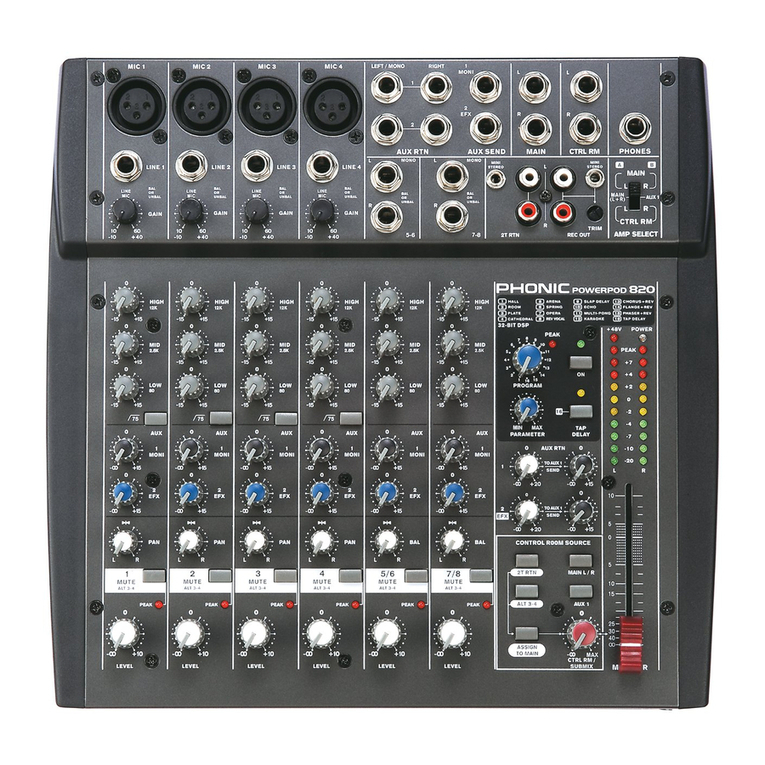
Phonic
Phonic POWERPOD 820 User manual
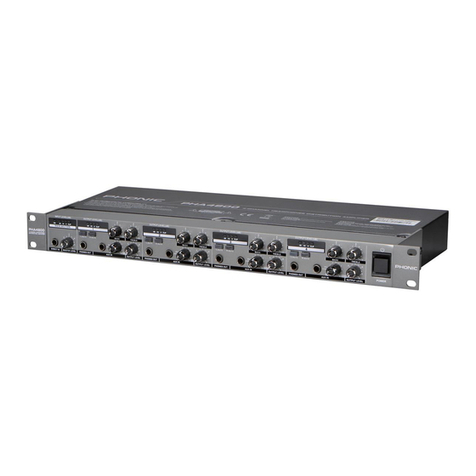
Phonic
Phonic PHA 4800 User manual
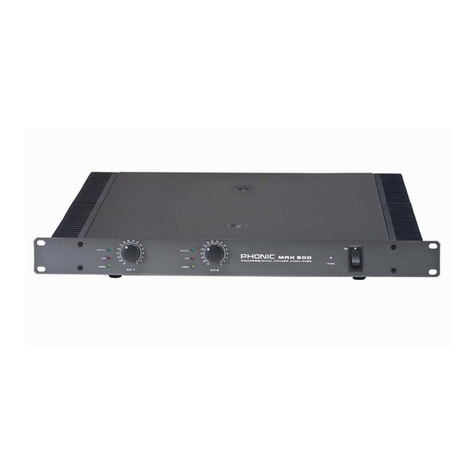
Phonic
Phonic MAX 500 User manual
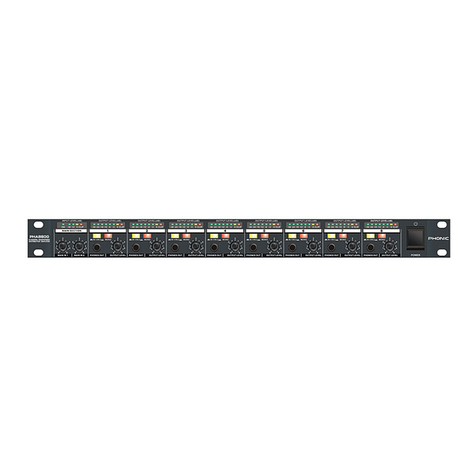
Phonic
Phonic PHA 8800 User manual
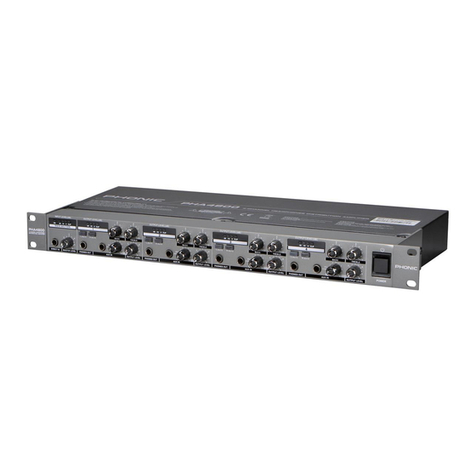
Phonic
Phonic PHA 4800 User manual

Phonic
Phonic XP1000 User manual
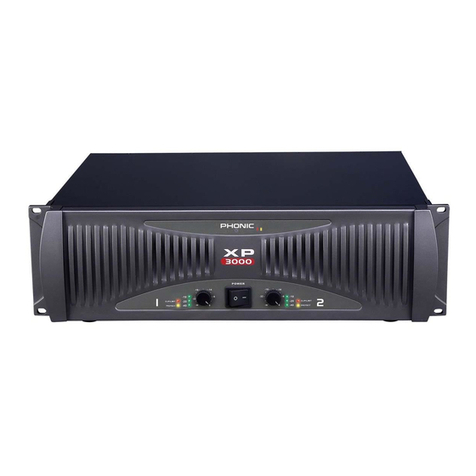
Phonic
Phonic XP 3000 User manual
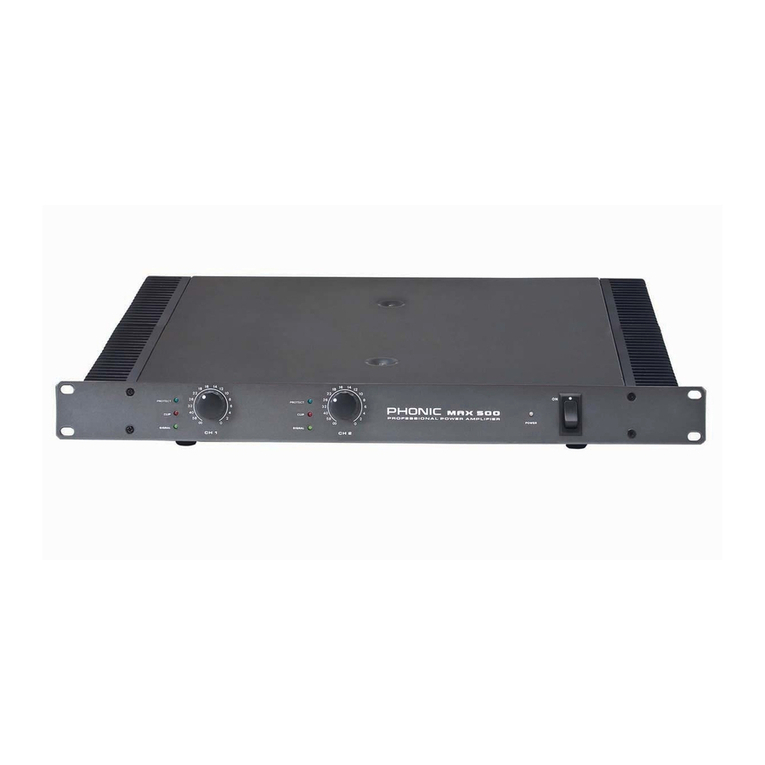
Phonic
Phonic MAX 250 User manual

Phonic
Phonic XP 600 User manual
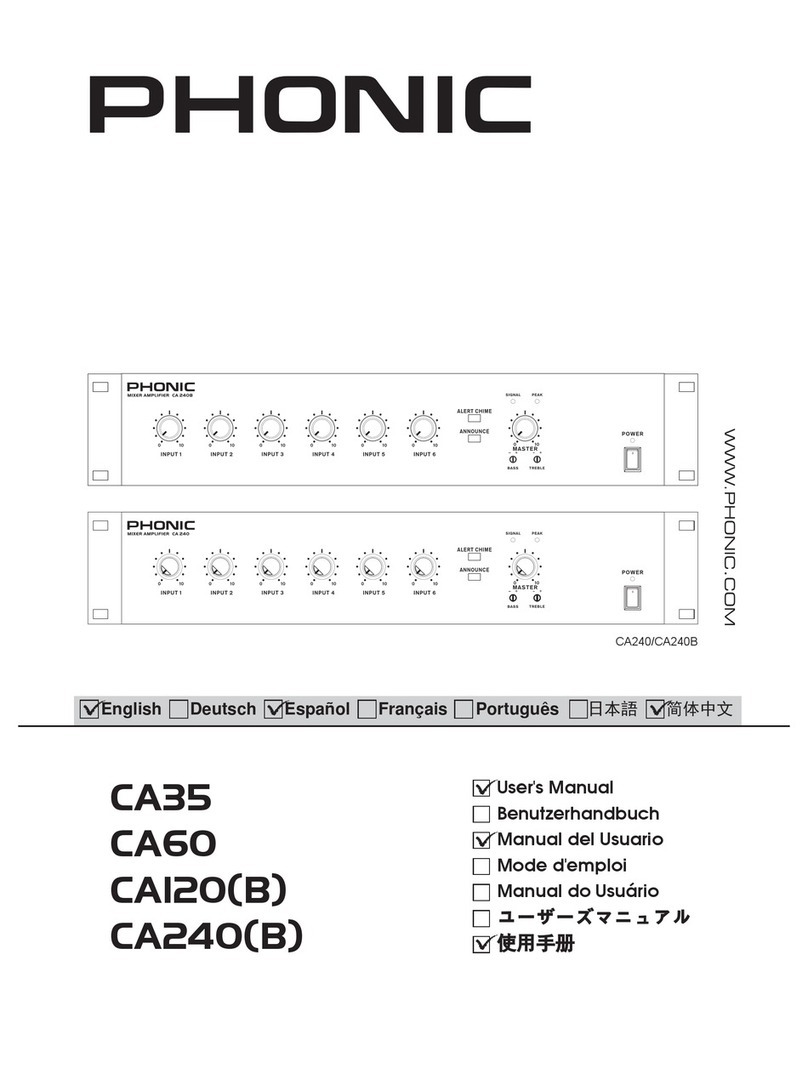
Phonic
Phonic CA35 User manual

Phonic
Phonic MAX 2500 plus User manual
Phonic
Phonic ICON 300 User manual
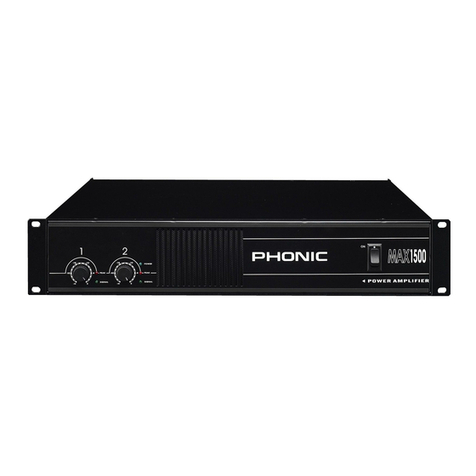
Phonic
Phonic MAX Series User manual

Phonic
Phonic DMX802 User manual

Phonic
Phonic ZAIOO User manual
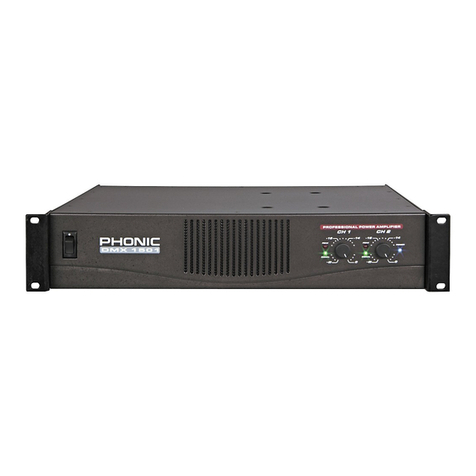
Phonic
Phonic DMX1501 User manual
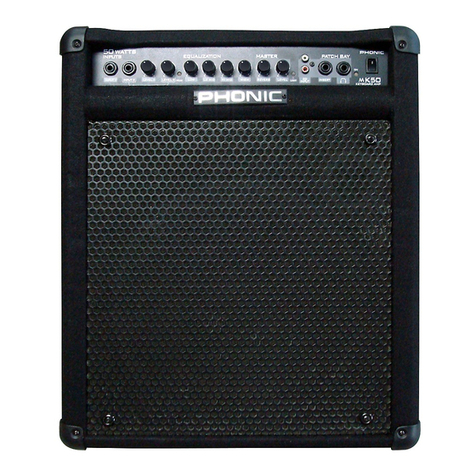
Phonic
Phonic MK15 User manual
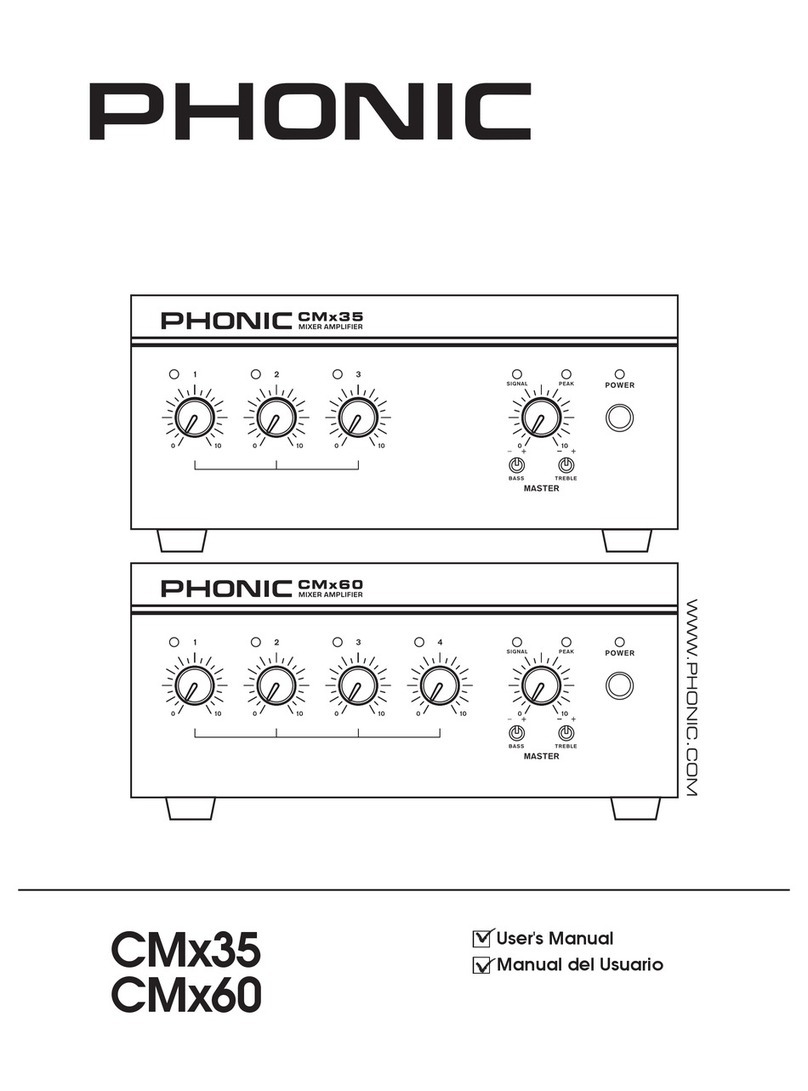
Phonic
Phonic CMx35 User manual
